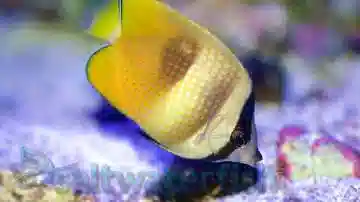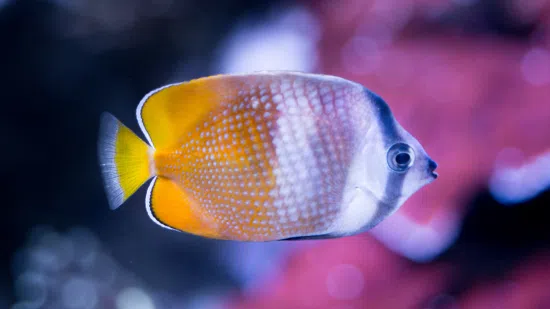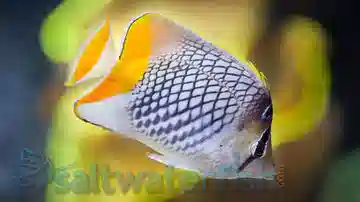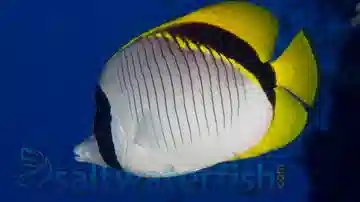Lined Butterfly
Chaetodon lineolatus
(1 Reviews)

Lined Butterfly
Chaetodon lineolatus
(1 Reviews)
{{ item.name }}
Size: {{ item.extra_field_3 }}
${{ getFormattedPrice(item.saleprice) }} ${{ getFormattedPrice(item.price) }}
To join the waiting list, click here
Free Shipping
With
$199.00
or more in Marine Life.
More details...
Lined Butterfly Care Facts
| Care Level: | Moderate |
|---|---|
| Temperament: | Peaceful |
| Diet: | Omnivore |
| Reef Safe: | No |
| Minimum Tank Size: | 120 gallons |
| Max Size: | 12 inches |
Introduction to the Lined Butterfly (Chaetodon lineolatus)
The Lined Butterfly, scientifically known as Chaetodon lineolatus, is a captivating addition to saltwater marine aquariums, cherished by hobbyists for its vibrant appearance and relatively manageable care requirements. This species, also known by other common names such as Striped Butterflyfish, hails from the Indo-Pacific region, adding a touch of exotic beauty to your aquatic environment.
Habitat of the Lined Butterfly
In their natural habitat, Lined Butterflies are found in coral-rich areas, particularly around reef flats and slopes. They gravitate towards environments with abundant coral cover, where they can seek shelter and find their preferred diet of coral polyps, small invertebrates, and algae.
Reef Safety for the Lined Butterfly
While the Lined Butterfly generally coexists peacefully with coral reefs in the wild, caution is advised when considering its compatibility with a reef aquarium. Some individuals may develop a taste for coral polyps, posing a potential threat to the well-being of your reef ecosystem. Therefore, it is recommended to monitor their behavior closely, especially during the initial acclimation period.
Size and Lifespan of the Lined Butterfly
Lined Butterflies exhibit a moderate size, reaching an average length of 12 inches in captivity. With proper care, these fish can live up to 5 to 7 years, making them a rewarding long-term addition to your marine aquarium.
Diet in Captivity for the Lined Butterfly
In a home aquarium, it is crucial to replicate the Lined Butterfly's natural diet. Offer a varied menu of high-quality frozen or live foods, such as Mysis shrimp, brine shrimp, and finely chopped seafood. Additionally, supplement their diet with a reputable herbivore-specific flake or pellet food to ensure a well-balanced nutritional intake.
Aquaculture Availability of the Lined Butterfly
Lined Butterflies are not widely aquacultured, making them primarily sourced from the wild. While efforts are underway to increase their availability through sustainable aquaculture practices, it's essential to choose specimens that have been responsibly collected to support the health of wild populations.
Compatibility of the Lined Butterfly
Lined Butterflies generally exhibit a peaceful temperament, making them suitable for community aquariums. However, caution should be exercised to ensure compatibility when selecting tank mates. Avoid housing them with aggressive or territorial species that may intimidate or harm these graceful butterflies.
Sexual Dimorphism in the Lined Butterfly
Sexual dimorphism in Lined Butterflies is not readily apparent, as males and females share similar external characteristics. Therefore, distinguishing between the sexes is only possible with specialized techniques.
Juvenile to Adult Coloration Changes in the Lined Butterfly
The coloration of Lined Butterflies undergoes a remarkable transformation as they mature. Juveniles display a striking contrast of vibrant blue lines against a yellowish background. The blue lines become more pronounced as they reach adulthood, creating a captivating pattern that enhances their overall beauty.
Tank Requirements for the Lined Butterfly
A minimum aquarium size of 120 gallons is recommended for a single Lined Butterfly to provide optimal living conditions. Adequate hiding places like live rock formations should be incorporated into the tank to mimic their natural habitat. Maintain stable water parameters to ensure the well-being of these sensitive creatures.
Water Conditions for the Lined Butterfly
pH: 8.1 to 8.4
Salinity: 1.023 to 1.025
Water Temperature: 75 to 82°F
Water Flow: Moderate to high, replicating their natural environment.
Other Common Names of the Lined Butterfly
Aside from Lined Butterfly and Striped Butterflyfish, this species may also be called the Yellow-lined Butterflyfish or Blue-striped Butterflyfish in different regions.
Five Compatible Tank Mates for the Lined Butterfly
- Flame Angelfish (Centropyge loriculus)
- Royal Gramma (Gramma loreto)
- Banggai Cardinalfish (Pterapogon kauderni)
- Purple Firefish (Nemateleotris decora)
- Coral Beauty Angelfish (Centropyge bispinosa)
Why Choose Saltwaterfish.com for the Lined Butterfly
When considering the purchase of a Lined Butterfly, Saltwaterfish.com stands out as a reliable source dedicated to delivering healthy, sustainably sourced marine life to enthusiasts. Their commitment to responsible collection and shipping practices ensures a vibrant and thriving specimen backed by a satisfaction guarantee.
In Conclusion: The Lined Butterfly in Your Aquarium
In conclusion, the Lined Butterfly is a mesmerizing addition to saltwater marine aquariums, bringing a touch of the Indo-Pacific's beauty to your home. Careful consideration of their habitat, compatibility, and nutritional needs, combined with responsible sourcing from reputable suppliers like Saltwaterfish.com, ensures a fulfilling and sustainable experience for marine enthusiasts.
Lined Butterfly great addition to 28g Biocube reef tank. Very healthy and active. Add great color to coral tank.
Reviewed by: Les Milston on Sept. 11, 2021















